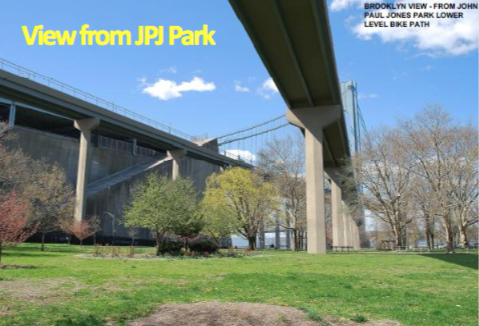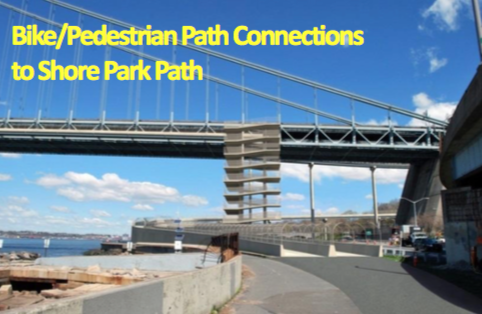
How much will it cost to build bicycle and pedestrian paths on the Verrazano Bridge? A lot less than the MTA says it will, if the agency removes unnecessary ramps from the project, according to advocates and engineers who've reviewed the options.
Last year, the MTA and engineering firm Parsons Brinckerhoff released a preliminary cost estimate of $300 to $400 million for the bridge paths [PDF]. It was a steeper price than advocates with the Harbor Ring Committee, which has built momentum for the car-free paths, had been expecting. Back in 1997, engineering firm Amman & Whitney had pegged the cost at $50-60 million (in 2016 dollars).
In an interview published yesterday on Urban Omnibus, Harbor Ring Committee chair Paul Gertner attributed the MTA's high pricetag to the design for the Brooklyn approach, which includes elaborate ramps connecting to the Shore Parkway Greenway. It's not clear how much the ramp system adds to the MTA's cost estimate, but the structures would be substantial, with concrete columns supporting a winding bikeway that touches down on the greenway.
"As far as we can tell, [Parsons Brinckerhoff] started with the assumption that it had to start at the waterfront greenway, and then proceeded to design this huge ramp system," Gertner said.
A greenway landing isn't worth the extra cost, Gertner told Streetsblog, since it would compel anyone who's not planning to use the greenway to take a long detour. In the Amman & Whitney plan, the path touched down at 92nd Street by Fourth Avenue, a much more direct connection to the street network.

A greenway connection could still be implemented using much cheaper on-street bike lanes. "You could stripe four or five blocks easily, and get cyclists to the greenway if they want to go to the greenway,” Gertner said. "In terms of people really using this for traveling around the city, there are a lot of really good reasons for putting it closer to the street network."
Skeptical of the preliminary design work released last year, Gertner took retired bridge engineer Joseph Pullaro on a tour of the Brooklyn side of the Verrazano. Until 2014, Pullaro owned the firm Lichtenstein Consulting Engineers, which restored Manhattan's High Bridge and helped rebuild Minneapolis' I-35 Mississippi River Bridge after it collapsed in 2007.
"He read the Ammann & Whitney report, he looked at the Parsons Brinckerhoff report, and we drove around together," Gertner said. "He said that the Ammann & Whitney plan for the lower level was still viable from an engineering standpoint." Gertner said Pullaro is willing to share his analysis -- which estimates a lower level path would cost about $50 million -- with the MTA, but the agency has yet to take him up on the offer.
The MTA has floated either a lower level option or an upper level option, but both include the Brooklyn ramps.
The MTA says Parsons Brinckerhoff's final master plan for the bridge should be released by the end of this year, two years behind schedule.





